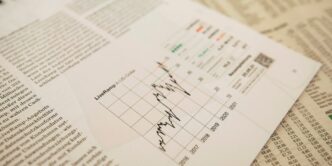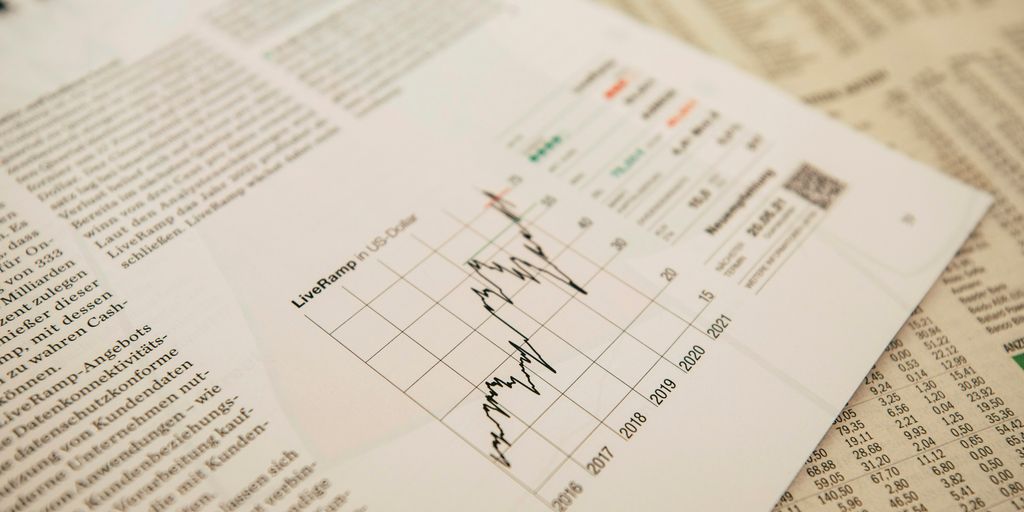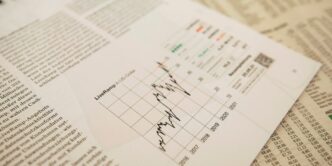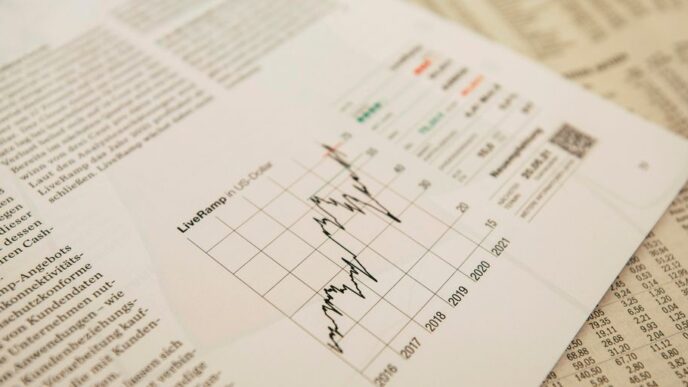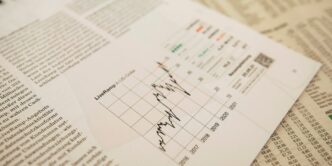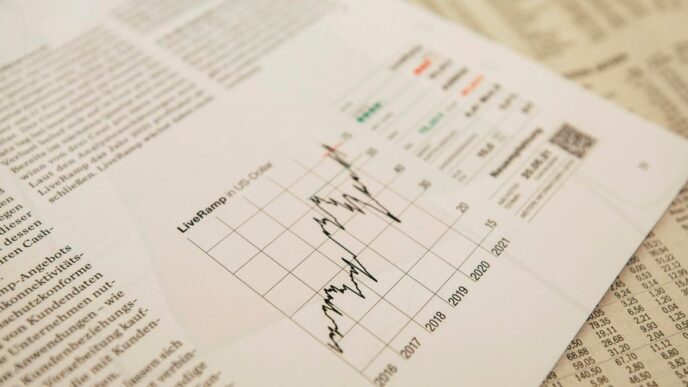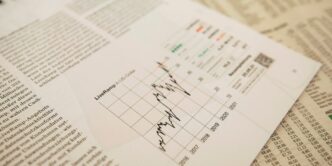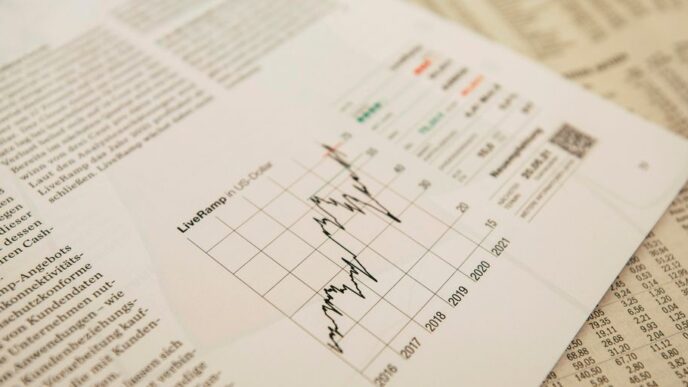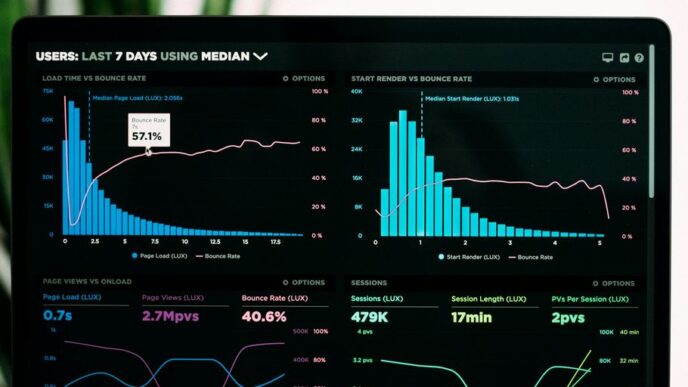So, you’re trying to figure out what’s up with 2 year bond interest rates? It can seem a bit confusing at first, but it’s really important for understanding the economy and even your own money. These rates tell us a lot about what people expect for the future, like inflation and economic growth. We’ll break down what 2 year bond interest rates are, what makes them go up or down, and why they matter to you, especially if you’re thinking about investing. Let’s get into it.
Key Takeaways
- 2 year bond interest rates are basically the returns you get from a US government bond that matures in two years. They are a big deal for understanding the overall health of the US economy.
- Things like how much prices are going up (inflation), how fast the economy is growing, and what the central bank decides to do with its policies all play a part in setting these rates.
- The yield curve, which shows the difference between short-term and long-term rates, helps us see what the market thinks about the future. 2 year bond interest rates are a key part of this curve.
- Investing in bonds, even short-term ones, comes with some risks. You need to think about how changes in interest rates can affect your bond’s value and if the issuer might not pay you back.
- Knowing about 2 year bond interest rates can help you make smarter choices with your investments. They can help you figure out how bond prices might change and how to spread out your money to reduce risk.
Defining 2 Year Bond Interest Rates
Understanding the 2 Year Treasury Rate
Okay, so what is the 2 Year Treasury Rate? Basically, it’s the yield you get for investing in a U.S. government-backed bond that matures in two years. Think of it as the government borrowing money from you for two years, and this rate is the ‘interest’ they pay. It’s a key indicator because it reflects market expectations for near-term economic conditions and monetary policy.
To give you some context, the 2 Year Treasury Rate is currently at 3.78%, which is higher than its long-term average of 3.24%. It even hit a low of 0.16% after the Great Recession. You can track the yield curve to see how it compares to other maturities.
Significance of Short-Term Yields
Why should you even care about short-term yields? Well, they’re like the pulse of the market. They react quickly to changes in economic data and Federal Reserve policy. Here’s why they matter:
- Economic Barometer: Short-term yields often move in anticipation of economic growth or slowdown. Rising yields can signal an expanding economy, while falling yields might suggest a recession is on the horizon.
- Monetary Policy Gauge: The Fed’s actions directly influence short-term rates. When the Fed raises its benchmark rate, short-term yields tend to follow suit. This makes them a good indicator of the central bank’s stance.
- Funding Costs: Short-term yields affect borrowing costs for businesses and consumers. Higher yields can translate to more expensive loans, potentially slowing down economic activity. Understanding the Buy Now Pay Later market is also important.
Historical Context of 2 Year Bond Interest Rates
Looking back at history can give us some perspective. The 2 Year Treasury Rate has seen its share of ups and downs. During periods of strong economic growth and rising inflation, the rate has generally climbed. Conversely, during recessions or times of economic uncertainty, it has often fallen as investors flock to the safety of government bonds.
Here’s a simplified look at how it’s behaved over time:
| Time Period | Economic Climate | Typical 2 Year Treasury Rate | Notes |
|---|---|---|---|
| Pre-Great Recession | Strong Growth, Low Rates | 4% – 5% | Housing boom, easy credit conditions. |
| Post-Great Recession | Low Growth, Low Inflation | 0.16% – 2% | Fed kept rates near zero to stimulate the economy. |
| Recent Years | Rising Inflation | 3% – 5% | Fed started raising rates to combat inflation. |
Factors Influencing 2 Year Bond Interest Rates
Impact of Inflation Expectations
Inflation is a big deal when it comes to bond yields. If people think inflation is going up, the interest rates on 2-year bonds usually follow suit. That’s because investors want to be compensated for the declining purchasing power of their money. It’s like, if you know your dollar won’t buy as much in two years, you’re going to want a higher return on your investment to make up for it. The market’s inflation forecasts really drive this.
Role of Economic Growth Projections
How the economy is expected to perform also plays a significant role. If the economy is projected to grow quickly, there’s usually an increased demand for credit, which can push interest rates higher. Think of it like this: businesses need money to expand, and consumers might be more willing to take out loans. This increased demand puts upward pressure on rates. On the flip side, if economic growth is expected to be slow, or even contract, interest rates might stay low or even decrease as demand for credit weakens.
Central Bank Monetary Policy Decisions
The central bank, like the Federal Reserve, has a huge influence on short-term interest rates. They use tools like the federal funds rate to manage the economy. When the Fed raises rates, it becomes more expensive for banks to borrow money, and this cost eventually trickles down to consumers and businesses. This often leads to higher yields on 2 year treasury rate. Conversely, when the Fed lowers rates, it makes borrowing cheaper, which can lead to lower bond yields. It’s all about managing the money supply and keeping the economy on track. The Fed’s decisions are closely watched by investors because they can have a pretty immediate impact on the bond market.
Here’s a quick summary of how these factors interact:
- Inflation Expectations: Higher inflation expectations generally lead to higher 2-year bond yields.
- Economic Growth: Strong economic growth can push yields higher, while weak growth can lower them.
- Central Bank Policy: The Fed’s actions directly influence short-term rates, impacting 2-year bond yields.
The Yield Curve and 2 Year Bond Interest Rates
Interpreting Yield Curve Movements
The yield curve is basically a snapshot of interest rates for bonds with different maturity dates. It’s a line that plots the yields of bonds (like government bond yields) against their maturity dates. Usually, you’ll see it sloping upwards – that means longer-term bonds have higher yields than shorter-term ones. This makes sense because investors usually demand more compensation for tying up their money for longer periods. But sometimes, the curve can flatten, invert (slope downwards), or steepen, and each of these movements tells a story about what the market expects for the economy.
- Steepening: Often happens when the economy is expected to improve. Longer-term rates rise faster than short-term rates.
- Flattening: Can signal economic uncertainty. The difference between long-term and short-term rates narrows.
- Inversion: This is when short-term rates are higher than long-term rates, and it’s often seen as a predictor of a recession. It suggests that investors expect the central bank to lower rates in the future due to a weakening economy.
How Market Forces Shape the Yield Curve
Several market forces influence the shape of the yield curve. Supply and demand for bonds play a big role. For example, if there’s high demand for long-term bonds, their prices will rise, and their yields will fall, potentially flattening the curve. Economic data releases, like inflation reports and GDP figures, also have a significant impact. Strong economic data can push yields higher, while weak data can pull them lower. Central bank actions, like raising or lowering interest rates, primarily affect the short end of the curve, but their announcements and forward guidance can influence the entire curve. Investor sentiment and risk appetite also play a role; in times of uncertainty, investors might flock to the safety of government bonds, pushing yields down.
Relationship Between Short and Long-Term Rates
The relationship between short-term and long-term rates is a key indicator of economic expectations. Short-term rates, like the 2-year Treasury rate, are heavily influenced by the Federal Reserve’s monetary policy. The Fed directly controls the federal funds rate, which affects short-term borrowing costs. Long-term rates, on the other hand, are more influenced by expectations about future economic growth and inflation. Investors demand a premium for lending money over longer periods, which is why long-term rates are usually higher than short-term rates. However, when investors expect a slowdown in economic growth or a decrease in inflation, long-term rates may fall, causing the yield curve to flatten or even invert. For example, the term to maturity impacts the yield curve.
Currently, the 10-year Treasury yields 0.44% more than the 2-year Treasury. By comparison, since 1977, 10-year Treasuries have historically averaged near a 0.8% yield spread over 2-year Treasuries. The 2 Year Treasury Rate (I:2YTCMR) was 3.78% for Jul 01 2025. You can use a yield curve tool to track the full US Treasury yield curve.
Risks Associated with 2 Year Bond Interest Rates
Understanding Interest Rate Risk
Okay, so here’s the deal with interest rate risk. Basically, when interest rates go up, the value of existing bonds tends to go down, and vice versa. Think of it like this: if you’re holding a bond paying 3%, and new bonds are issued paying 4%, your bond suddenly looks less attractive. Nobody wants your old, low-paying bond when they can get a shiny new one with a higher yield. This is especially true for bonds with longer maturities, but it still affects 2-year bonds, just to a lesser extent. It’s something to keep in mind when you’re looking at government bond yields.
Inflation’s Erosion of Bond Value
Inflation is another biggie. You might think you’re getting a decent return on your 2-year bond, but if inflation is running higher than your yield, you’re actually losing money in terms of purchasing power. Your bond might be paying you dollars, but those dollars are worth less than they used to be. It’s like running on a treadmill – you’re working hard, but not really going anywhere. This is why it’s important to keep an eye on inflation expectations. If inflation is expected to rise, the real return on your bond (the return after accounting for inflation) could be significantly lower than you anticipated. It’s a silent killer of bond returns, so pay attention to inflation data!
Assessing Credit Risk in Bond Investments
While 2-year Treasury bonds are generally considered very safe because they’re backed by the U.S. government, it’s still important to understand credit risk, especially if you’re venturing into other types of bonds. Credit risk is the risk that the issuer of the bond might default on their payments. With U.S. Treasuries, this risk is minimal, but with corporate bonds or municipal bonds, it’s something you need to consider. Credit rating agencies like Moody’s and Standard & Poor’s assess the creditworthiness of bond issuers, and their ratings can give you an idea of the level of risk involved. A lower rating means a higher risk of default, and usually a higher yield to compensate for that risk. So, while a higher yield might look tempting, make sure you understand the 2-year muni bond yield and the underlying credit risk before you jump in.
Investment Implications of 2 Year Bond Interest Rates
Bond Pricing and Interest Rate Changes
Okay, so how do these 2-year bond rates actually impact your investments? Well, it’s pretty straightforward: when interest rates go up, bond prices generally go down, and vice versa fixed income securities. Think of it like a seesaw. If the interest rate on new bonds is higher, nobody wants to pay as much for older bonds with lower rates. The price has to drop to make them attractive again. The opposite happens when rates fall.
Strategic Considerations for Investors
For investors, the 2-year Treasury can be a useful tool. Here’s a few things to consider:
- Short-Term Focus: If you think interest rates are going to rise soon, investing in 2-year bonds can be a good way to park your money without locking it up for too long. You can then reinvest at the higher rates when the bond matures.
- Risk Management: 2-year bonds are generally less sensitive to interest rate changes than longer-term bonds. This means they’re a bit safer if you’re worried about rates jumping around.
- Yield Curve Insights: Keep an eye on the yield curve tool. If the 2-year yield is higher than the 10-year yield (an inverted yield curve), it could signal an economic slowdown. This might influence your overall investment strategy.
Diversifying Portfolios with Short-Term Bonds
Don’t put all your eggs in one basket! Diversification is key. Short-term bonds, like the 2-year Treasury, can play a role in a well-rounded portfolio. They can:
- Reduce Volatility: Because they’re less sensitive to interest rate swings, they can help stabilize your portfolio.
- Provide Liquidity: They mature relatively quickly, giving you access to your cash sooner than longer-term bonds.
- Balance Risk: They can offset the riskier parts of your portfolio, like stocks or high-yield bonds. Remember to consult with a financial advisor to determine the best asset allocation for your individual circumstances and risk tolerance. It’s always a good idea to get personalized advice!
Current Market Snapshot of 2 Year Bond Interest Rates

Analyzing Today’s 2 Year Treasury Rate
Okay, so let’s talk about where the 2-year Treasury rate is sitting right now. As of July 1, 2025, it’s around 3.78%. That’s the yield you’d get for investing in a Treasury security that matures in two years. This rate is a pretty important indicator of what’s happening in the short-term part of the yield curve. It’s something to keep an eye on if you’re trying to understand the overall health of the U.S. economy. If you’re thinking about fixed-term contract mortgages, understanding these rates is a good idea.
Comparing Current Rates to Historical Averages
How does 3.78% stack up against what we’ve seen in the past? Well, the long-term average is somewhere around 3.24%. So, we’re a bit above that right now. Historically, we’ve seen some pretty low rates, like 0.16% after the Great Recession. Here’s a quick look at how things have changed:
- Pre-Recession (2006-2007): Averaged around 4.5%
- Post-Recession (2010-2012): Hovered between 0.2% and 0.5%
- Recent Years (2023-Present): Increased from near-zero to current levels
This kind of comparison gives you some context. It shows whether rates are relatively high, low, or somewhere in the middle compared to what we’ve seen before. It’s all about perspective, right?
Future Outlook for 2 Year Bond Interest Rates
Predicting the future is always tricky, but here’s what some folks are thinking about where the 2-year Treasury rate might be headed. A lot depends on what the Federal Reserve decides to do with monetary policy. If they keep raising interest rates to fight inflation, we could see the 2-year yield go up. If the economy starts to slow down, they might cut rates, which would likely push the 2-year yield lower. Also, keep an eye on inflation expectations. If people think inflation is going to stay high, that could also put upward pressure on the 2-year yield. It’s a bit of a guessing game, but these are some of the key things to watch:
- Federal Reserve Actions: Rate hikes or cuts
- Inflation Data: Consumer Price Index (CPI) and Producer Price Index (PPI)
- Economic Growth: GDP reports and employment figures
Conclusion
So, what’s the takeaway here? Two-year bond rates are a pretty good indicator of what’s happening in the economy. They react to things like what the Fed is doing with interest rates and how people feel about inflation. Keeping an eye on these rates can give you a heads-up on where things might be going. It’s not always a straight line, but understanding these bonds helps you get a better picture of the financial world around us.
Frequently Asked Questions
What exactly is a 2-year bond interest rate?
A 2-year bond interest rate tells you how much money you’ll earn on a special loan to the U.S. government over two years. It’s like the rent you get for letting the government use your money for that time. This rate is super important because it gives us clues about how the economy is doing in the short term.
What makes 2-year bond interest rates go up or down?
Many things can change this rate. If people think prices will go up a lot (inflation), the rate usually goes higher. Also, if the economy is growing fast, rates tend to climb. And don’t forget the Federal Reserve, our country’s central bank; their decisions on borrowing money have a big impact.
How does the ‘yield curve’ relate to these rates?
The yield curve is a graph that shows interest rates for bonds of different lengths, from short (like 2 years) to long (like 30 years). When the curve changes shape, it can tell us if people expect the economy to get stronger or weaker. The 2-year rate is a key point on this curve.
Are there any risks when investing in 2-year bonds?
Yes, there are a few things to watch out for. One is ‘interest rate risk,’ meaning if rates go up after you buy a bond, your bond might not be worth as much. Another is ‘inflation risk,’ where rising prices can make the money you get back from your bond less valuable. Also, ‘credit risk’ is about whether the borrower (in this case, the U.S. government, which is very safe) can pay you back.
How do changes in these rates affect bond prices and my investments?
When interest rates change, the price of existing bonds moves in the opposite direction. If rates go up, your old bonds might be worth less. For investors, 2-year bonds can be a good way to keep your money safe and earn a little extra, especially if you think interest rates might go down soon. They can also help balance out a portfolio with other, riskier investments.
What is the current 2-year bond interest rate and how does it compare to the past?
Right now, the 2-year Treasury rate is about 3.78%. This is a bit higher than what it’s been on average over a long time, which was 3.24%. It’s also lower than last year’s rate of 4.77%. Experts are always watching these numbers to guess where rates might go next, which helps investors make smart choices.

